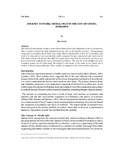Please use this identifier to cite or link to this item:
https://cris.library.msu.ac.zw//handle/11408/735Full metadata record
| DC Field | Value | Language |
|---|---|---|
| dc.contributor.author | Jerie, Steven | - |
| dc.date.accessioned | 2015-12-04T07:45:42Z | - |
| dc.date.available | 2015-12-04T07:45:42Z | - |
| dc.date.issued | 2006 | - |
| dc.identifier.issn | 1815-9036 | - |
| dc.identifier.uri | http://hdl.handle.net/11408/735 | - |
| dc.description.abstract | The thrust of urban planners today is to develop methods of travel for adaptation to their environments.This is meant to match the high population growth rates in developing countries. Transportation congestion is a problem faced many cities today. Routes and facilities tend to be overloaded, trips tend to be long and services provided for public transport become inconsistent and inconvenient. This study examines the factors that influence modes of travel used by the commuters in Gweru as a first step towards isolating the causes of transport problems. This way the needs of different socioeconomic groups can be understood. An attempt is also made in this study to use simple travel models in determining modal split. These models are adapted in the context of the study area. | en_US |
| dc.language.iso | en | en_US |
| dc.publisher | Midlands State University | en_US |
| dc.relation.ispartofseries | The Dyke;Vol.2, No. 1; p.84-94 | - |
| dc.subject | Population growth | en_US |
| dc.subject | Developing countires | en_US |
| dc.title | Journey to work: modal split in the city of Gweru, Zimbabwe | en_US |
| dc.type | Article | en_US |
| item.grantfulltext | open | - |
| item.openairetype | Article | - |
| item.openairecristype | http://purl.org/coar/resource_type/c_18cf | - |
| item.fulltext | With Fulltext | - |
| item.cerifentitytype | Publications | - |
| item.languageiso639-1 | en | - |
| Appears in Collections: | Research Papers | |
Files in This Item:
| File | Description | Size | Format | |
|---|---|---|---|---|
| journey.pdf | 201.68 kB | Adobe PDF |  View/Open |
Page view(s)
18
checked on Jul 27, 2024
Download(s)
6
checked on Jul 27, 2024
Google ScholarTM
Check
Items in MSUIR are protected by copyright, with all rights reserved, unless otherwise indicated.


